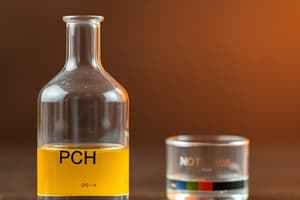Podcast
Questions and Answers
What type of alcohol is ethanol classified as?
What type of alcohol is ethanol classified as?
- Primary Alcohol (correct)
- Secondary Alcohol
- Tertiary Alcohol
- None of the above
Give an example of a secondary alcohol.
Give an example of a secondary alcohol.
2-Propanol (isopropyl alcohol)
What is an example of a tertiary alcohol?
What is an example of a tertiary alcohol?
2-Methyl-2-propanol (t-butyl alcohol)
Phenols structurally resemble alcohols because they contain a hydroxyl group.
Phenols structurally resemble alcohols because they contain a hydroxyl group.
Which of the following is true about properties of phenols?
Which of the following is true about properties of phenols?
What property of alcohols increases with the number of hydroxyl groups?
What property of alcohols increases with the number of hydroxyl groups?
Match the following alcohol types with their oxidation products:
Match the following alcohol types with their oxidation products:
The test used to distinguish primary and secondary alcohols from tertiary alcohols is called the ______ Test.
The test used to distinguish primary and secondary alcohols from tertiary alcohols is called the ______ Test.
In the Lucas Test, a tertiary alcohol gives an insoluble white layer immediately after the addition of ______.
In the Lucas Test, a tertiary alcohol gives an insoluble white layer immediately after the addition of ______.
Flashcards are hidden until you start studying
Study Notes
Classification of Alcohols
- Primary Alcohol: Characterized by the hydroxyl group attached to a primary carbon; example is ethanol.
- Secondary Alcohol: Hydroxyl group is connected to a secondary carbon; 2-propanol (isopropyl alcohol) is a common example.
- Tertiary Alcohol: Hydroxyl group is bonded to a tertiary carbon; an example is 2-methyl-2-propanol (t-butyl alcohol).
Phenols
- Structurally similar to alcohols due to the presence of a hydroxyl (-OH) group.
Properties of Phenols
- More acidic than alcohols.
- Concentrated phenol solutions are toxic and can severely burn skin.
- Generally soluble in water and exhibit polar characteristics.
Properties of Alcohols
- Alcohols mix readily with water.
- Increased number of hydroxyl groups enhances hydrogen bonding with water, increasing solubility in water.
- Also soluble in organic solvents.
Chromic Acid Test
- Used to differentiate primary and secondary alcohols from tertiary alcohols using an acidified dichromate solution.
- Primary alcohols oxidize to carboxylic acids (turning chromic acid from red/brown to blue/green).
- Secondary alcohols oxidize to ketones, showing the same color change.
- Tertiary alcohols do not oxidize, showing no color change.
- Phenols oxidize into a brown tarry mass.
Lucas Test
- Distinguishes among primary, secondary, and tertiary alcohols using Lucas reagent (zinc chloride in concentrated HCl).
- Tertiary alcohols react rapidly, forming an insoluble white layer immediately.
- Secondary alcohols react slowly and may require slight heating, producing a thin white layer within about 10 minutes.
- Primary alcohols do not react, showing no change at all.
- Formation of any heterogeneous phase indicates a positive result.
Studying That Suits You
Use AI to generate personalized quizzes and flashcards to suit your learning preferences.




